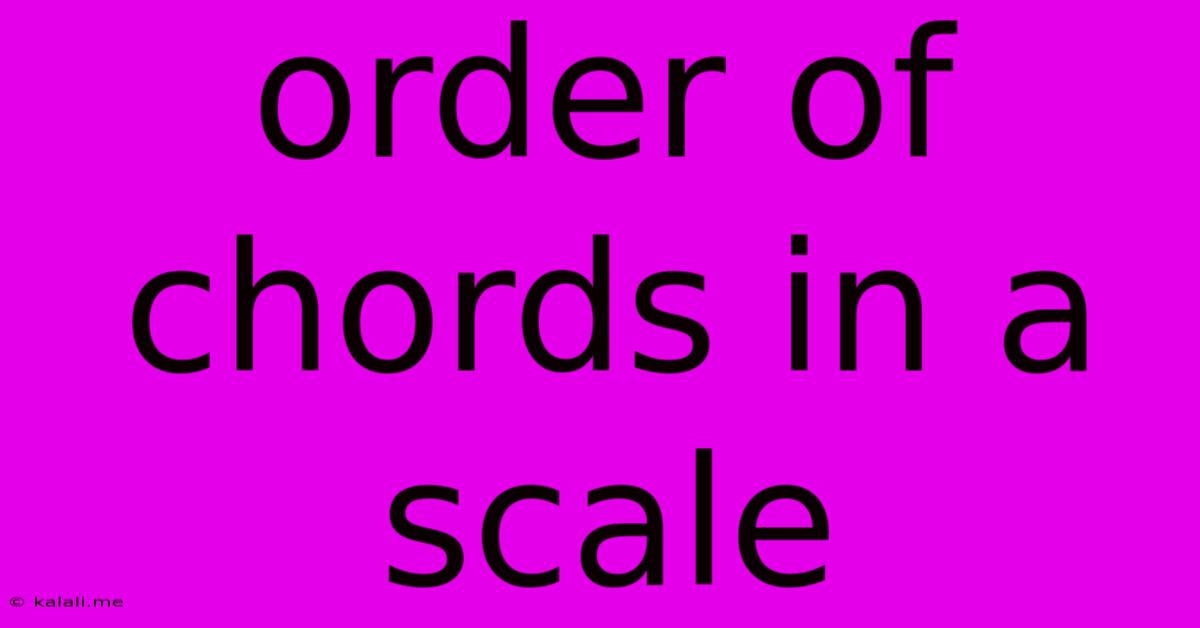Order Of Chords In A Scale
Kalali
Jun 06, 2025 · 3 min read

Table of Contents
Understanding Chord Progressions: The Order of Chords in a Scale
Understanding the order of chords within a musical scale is fundamental to composing and arranging music. This knowledge allows you to create compelling chord progressions that underpin melodies and create a satisfying musical experience for the listener. This article will explore the common chord progressions within major and minor scales, offering a foundational understanding for musicians of all levels. We'll look at how different chord qualities (major, minor, dominant, diminished) interact to create distinct moods and harmonic movement.
Major Scale Chord Progressions
The major scale is characterized by its bright and uplifting sound. Each major scale contains seven chords, built by stacking thirds on each scale degree. The Roman numeral system is used to represent these chords: I, II, III, IV, V, VI, VII.
- I (Tonic): This is the foundation of the scale, providing a sense of stability and resolution. It's always major.
- ii (Supertonic): Usually minor, it creates a sense of movement towards the dominant.
- iii (Mediant): Minor, often used to add color and a slightly melancholic feel.
- IV (Subdominant): Major, it creates a strong pull towards the dominant.
- V (Dominant): Major, this is a crucial chord, creating a strong sense of tension that resolves powerfully back to the tonic.
- vi (Submediant): Minor, often used for its lyrical and reflective quality.
- vii° (Leading-tone): Diminished, this chord powerfully resolves to the tonic.
Common Major Key Progressions:
- I-IV-V-I: This is the quintessential and extremely common progression, providing a satisfying sense of resolution. Think of many popular songs; this progression is the backbone of countless hits.
- I-vi-IV-V: A more sophisticated variation, adding a touch of melancholy before the satisfying resolution.
- ii-V-I: A very common jazz progression, the ii-V creates a strong pull towards the tonic.
Minor Scale Chord Progressions
Minor scales, with their darker and more introspective character, offer different harmonic possibilities. There are three main types of minor scales: natural minor, harmonic minor, and melodic minor. Each has a unique set of chords and progressions.
- Natural Minor: This scale uses the natural notes of the minor scale. The chord progressions are similar to major, but with a darker tone. The Roman numeral system is used, but the chords' qualities differ: i, iim, III+, iv, V, VI, VII°.
- Harmonic Minor: This scale raises the 7th degree, creating a leading tone and a stronger pull towards the tonic. This alters the VII chord to a major chord (VII).
- Melodic Minor: This scale raises both the 6th and 7th degrees ascending, creating a brighter sound. Descending, it usually reverts to the natural minor scale. This has varied chord options, depending on whether the ascending or descending form is used.
Common Minor Key Progressions:
- i-iv-V-i: The equivalent of the I-IV-V-I in major, but with a minor key feeling.
- i-VI-IV-V: Similar to the major key variation, but with the characteristic minor tonality.
- ii-V-i: A common progression in minor key jazz and blues.
Exploring Beyond Basic Progressions
These are just the basic chord progressions. Experimentation is key! Try substituting chords, inverting chords, adding 7th chords, and using different rhythmic patterns to create unique and interesting sounds. Learning to hear the relationships between chords and how they function within the context of a key is the true path to mastering chord progressions. Listening to your favorite music and analyzing the chord progressions used can be a great way to learn and improve your understanding. Don't be afraid to break the rules and find your own musical voice.
This understanding of the order of chords in a scale will improve your ability to write your own music, analyze existing music, and enrich your overall musical experience. So grab your instrument, experiment, and enjoy the journey of musical discovery!
Latest Posts
Latest Posts
-
3 Way Light Switching Wiring Diagram
Jun 07, 2025
-
How Do You Invert A Picture
Jun 07, 2025
-
Dnd 5e So Much Homebrew Pf2
Jun 07, 2025
-
Ocarina Of Time Lost Woods Map
Jun 07, 2025
-
Mount Dry Erase Board Without Screws
Jun 07, 2025
Related Post
Thank you for visiting our website which covers about Order Of Chords In A Scale . We hope the information provided has been useful to you. Feel free to contact us if you have any questions or need further assistance. See you next time and don't miss to bookmark.